Abstract
BACKGROUND:
Noise pollution has become a major environmental problem leading to nuisances and health issues.
AIM:
This paper aims to study and analyse the noise pollution levels in major areas in Ota metropolis. A probability model which is capable of predicting the noise pollution level is also determined.
METHODS:
Datasets on the noise pollution level in 41 locations across Ota metropolis were used in this research. The datasets were collected thrice per day; morning, afternoon and evening. Descriptive statistics were performed, and analysis of variance was also conducted using Minitab version 17.0 software. Easy fit software was however used to select the appropriate probability model that would best describe the dataset.
RESULTS:
The noise levels are way far from the WHO recommendations. Also, there is no significant difference in the effects of the noise pollution level for all the times of the day considered. The log-logistic distribution provides the best fit to the dataset based on the Kolmogorov Smirnov goodness of fit test.
CONCLUSION:
The fitted probability model can help in the prediction of noise pollution and act as a yardstick in the reduction of noise pollution, thereby improving the public health of the populace.
Keywords: Environmental toxicity, Distribution, Nigeria, Noise Pollution, Public health
Introduction
Noise pollution is one of several environmental pollutions across the world. It can be described as the propagation of noise with a harmful impact on the physiological and psychological lives of humans or animals [1]. Noise or sound pollution is usually not studied compared with other forms of pollution such as air [2], [3], [4], water [5], soil [6], light and radioactive. The reason is that the adverse effects of other forms of pollution on humans are more pronounced. Notwithstanding, noise pollution remains a serious health concern in the study area (Ota, Nigeria) in particular and the entire planet [7], [8]. Some of the identified sources of noise pollution are loud music from concerts, religious buildings like churches and mosques, noise emitting generators [9], political rallies, road advertisement, traffic [10] and air transportation [11], sporting events, construction and industrial activities. In all the mentioned sources, areas that have high risk of noise pollution are residential places near to major roads [12] and airports and manufacturing industries [13]; for example, small scale industries [14], [15], steel rolling industries [16], oil and gas industry [17], [18] and so on.
The health effects of noise pollution cannot be over-emphasised. This has prompted the World Health Organization (WHO) and the Federal Environment Protection Agency (FEPA) (Nigeria) to set standards and limits of allowable noise levels. Noise pollution occurs when it is observed that those standards are exceeded as seen in [19], [20].
The most common manifestation of noise pollution is hearing loss or impairment [21]. Hearing impairment is mostly classified as occupational hazards especially when the individual is affiliated with industry that propagates loud sound or noise. Moreover, several physiological and psychological effects of noise pollution exist. The combination of noise and air pollution is associated with respiratory ailments, dizziness and tiredness in school children [22], [23]. In adults, noise pollution has been found to be associated with high blood pressure [24] and cognitive difficulties [25].
A look at the literature showed the abundance of evidence of the adverse effects of noise pollution on the general public health. The worsening situation of noise pollution is that it has not been upgraded to the level of the other forms of pollution. Also, recommendations suggested by several authors on the different strategies on tackling noise pollution has not been considered and implemented. However, noise pollution continues to impact negatively on fetal development [26], annoyance and anxiety [27], mental health crisis [28], sleep disturbance and insomnia [29], [30], cardiovascular disorders in pregnant women [31], cardiocerebrovascular diseases [32], type 2 diabetes incidence [33] and medically unexplained physical symptoms [34]. Other auditory and non-auditory effects of noise on health are myocardial infarction incidence [35], peptic ulcers [36] and disruption of communication and retentive capabilities in children [37].
This paper aims to study and analyse the noise pollution levels in major areas in Ota metropolis. A probability model which is capable of predicting the noise pollution level is also determined.
Material and Methods
The dataset used in this research was gotten from [38]. It represents the noise level in 41 major locations in Ota metropolis, Nigeria. These major areas include industrial areas, commercial areas, passenger loading parks, busy roads and junctions. The readings were taken using the SLM (Sound Level Meter). Measurements were taken three different times of the day; morning (7 am to 9 am), afternoon (1 pm to 3 pm) and evening (6 pm to 8 pm). Particularly, the noise pollution level (NLP) was considered and analysed in this present research.
Analysis of Variance
Analysis of variance is conducted in this research to know if there is a significant difference between the effect of noise pollution level in the morning, afternoon and evening in Ota metropolis. The hypothesis tested is:
H0: The effects of the noise pollution level are the same for morning, afternoon and evening
Versus
H1: The effects of the noise pollution level are not the same for at least one of either morning, afternoon or evening.
The level of significance used is 0.05, and the null hypothesis is considered rejected if the p-value is less or equal to the level of significance. The structure of the ANOVA table is such as presented in Table 1.
Table 1.
A typical example of a one-way ANOVA Table
| Source of Variation | Degree of Freedom | Sum of Square | Mean Square | F-value |
|---|---|---|---|---|
| Factor | f-1 | SSF | MSF = SSF/f-1 | MSF/MSE |
| Error | n-f | SSE | MSE = SSE/n-f | |
| Total | n-1 | SST |
where, ‘f’ is the number of factors which is 3 according to this research; morning, afternoon and evening. ‘n’ is the overall sample size.
The goodness of Fit Test
The goodness of fit test is performed in this research to select the probability model that best fits the dataset. The Kolmogorov Smirnov (KS) test, the Anderson Darling (AD) test and Chi-square test are examples of the goodness of fit tests.
The KS test was adopted in this research because it is the most popular and others might give similar results. The null hypothesis tests whether the data follow a specified distribution. If represent ordered data points, the KS statistic is:

where are the ordered data and is the cumulative distribution function (cdf) of the continuous distribution tested.
Results
Descriptive Analysis of the Dataset
The summary for the LNP measurements is provided in Figures 1 to 3 while the summary for the mean measurement across the 41 locations is provided in Figure 4.
Figure 1.
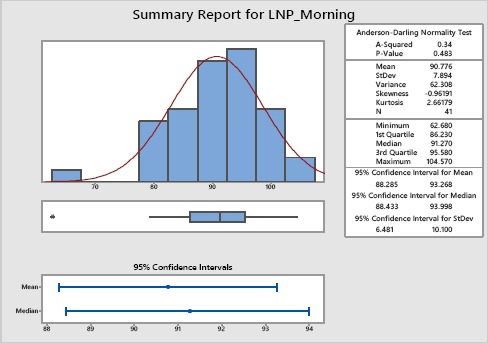
Summary report for morning measurements on LNP
Figure 3.
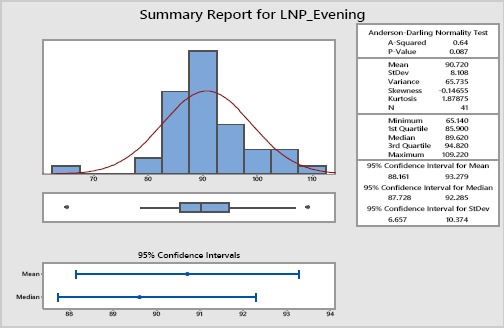
Summary report for evening measurements on LNP
Figure 4.

Summary report for the mean measurements of LNP across all locations in Ota
Figure 2.
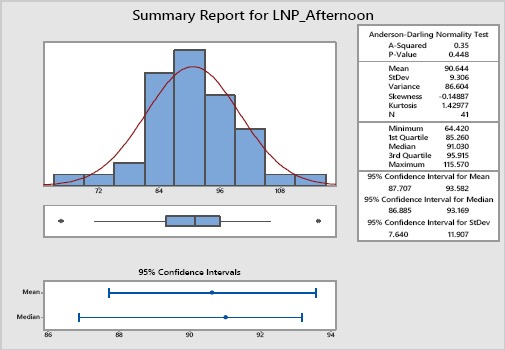
Summary report for afternoon measurements on LNP
Result for the Analysis of Variance
The analyses of the means of the various measurements are presented in Table 2.
Table 2.
Analysis of the Means
| Factor | N | Mean | Standard Deviation | 95% Confidence Interval |
|---|---|---|---|---|
| LNP_Morning | 41 | 90.78 | 7.89 | (88.16, 93.39) |
| LNP_Afternoon | 41 | 90.64 | 9.31 | (88.03, 93.26) |
| LNP_Evening | 41 | 90.72 | 8.11 | (88.10, 93.34) |
The 95% confidence interval (CI) plot for the means is displayed in Figure 5.
Figure 5.
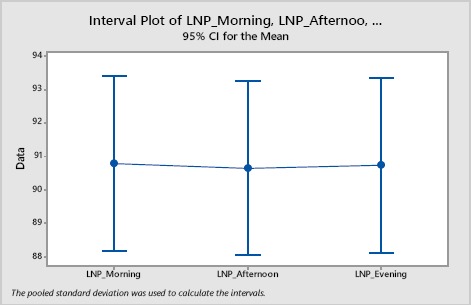
The 95% confidence interval (C.I) plot for the means
The result of the analysis of variance is presented in Table 3.
Table 3.
Analysis of Variance (ANOVA) Table
| Source | Degree of Freedom | Sum of Square | Mean Square | F-value | p-value |
|---|---|---|---|---|---|
| Factor | 2 | 0.36 | 0.1805 | 0.00 | 0.997 |
| Error | 120 | 8585.85 | 71.5487 | ||
| Total | 122 | 8586.21 |
The result in Table 3 shows that the generated p-value is 0.997 which is far greater than the level of significance (0.05). Hence, there is no enough evidence to reject the null hypothesis, and it can, therefore, be concluded that there is no significant difference in the means of the noise level measurements taken in the morning, afternoon and evening. This result is further confirmed by Turkey’s post-hoc test which is summarized in Figure 6.
Figure 6.
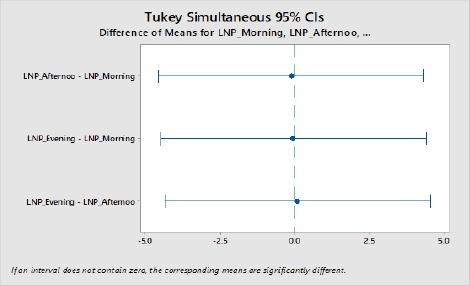
Summary of Turkey’s post-hoc analysis
It can be observed in Figure 6 that all the intervals contained zero; this is an indication that there is no significant difference in the pair of each of the measurements considered.
Fitting of Probability Models
To determine the appropriate probability model that describes the mean noise pollution level in Ota metropolis, Easyfit (trial version) software was used to select distribution with the best fit. The Kolmogorov-Smirnov (KS) test of goodness of fit was used to select the best model. The software fitted sixty distributions to the dataset, but the best five was reported in this research. The result is presented in Table 4.
Table 4.
Fitted Distributions
| Distributions | KS Statistic | Rank |
|---|---|---|
| Log-Logistic (3P) | 0.06236 | 1 |
| Burr | 0.06846 | 2 |
| Hypersecant | 0.07131 | 3 |
| Logistic | 0.08415 | 4 |
| Johnson SU | 0.08629 | 5 |
From Table 4, the best-fitted model is the three-parameter Log-logistic distribution; this selection/decision is based on the Kolmogorov Smirnov statistic. A graph showing the best distribution fitted to the dataset on mean noise pollution level is presented in Figure 7.
Figure 7.
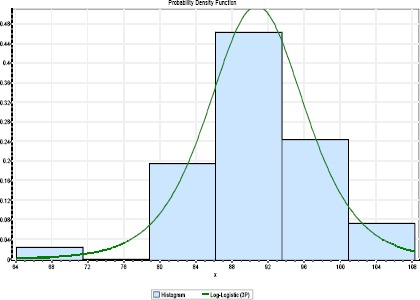
Graph of log-logistic distribution on the histogram of the dataset
In conclusion, further analyses of the noise pollution level in Ota metropolis has been provided in this research. The mean noise level in the morning was 90.78 which is higher than (though very close to) that of afternoon and evening with means 90.6 and 90.72 respectively. This is reasonable as more activities are expected during this time; pupils are going to school, workers going to the office, traffic at some junction and major bus stops. However, the analysis of variance result indicated that the time of the day (morning, afternoon and evening) have the same effect on the environment and populace. Also, the noise pollution level in Ota metropolis can be modelled using the log-logistic distribution as evident from the goodness of fit test. The model can now be used in predicting and managing noise pollution in that area. Furthermore, the model can be used in different geographical settings where noise pollution poses a perceived threat to the public health of the populace.
Footnotes
Funding: This research received financial support from the Covenant University
Competing Interests: The authors have declared that no competing interests exist
References
- 1.Oloruntoba EO, Ademola RA, Sridhar MKC, Agbola SA, Omokhodion FO, Ana GREE, Alabi RT. Urban environmental noise pollution and perceived health effects in Ibadan, Nigeria. Afr J Biomed Res. 2012;15(2):77–84. [Google Scholar]
- 2.Oguntunde PE, Odetunmibi OA, Adejumo AO. A study of probability models in monitoring environmental pollution in Nigeria. J Prob Stat 2014. 2014 Article ID 864965. https://doi.org/10.1155/2014/864965. [Google Scholar]
- 3.Anake WU, Bayode FO, Omonhinmin CA, Williams AB. Ambient air pollution control using air pollution tolerance index and anticipated performance index of trees. Int J Civil Eng Technol. 2018;9:417–425. [Google Scholar]
- 4.Okokpujie K, Noma-Osaghae E, Modupe O, John S, Oluwatosin O. A smart air pollution monitoring system. Int J Civil Engine Technol. 2018;9(9):799–809. [Google Scholar]
- 5.Omole DO, Ogbiye AS, Longe EO, Adewumi IK, Elemile OO, Tenebe TI. Water quality checks on river atuwara, south-west Nigeria. WIT Trans Ecol Environ. 2018;228:165–173. https://doi.org/10.2495/WP180171. [Google Scholar]
- 6.Oyeyemi KD, Aizebeokhai AP, Okagbue HI. Geostatistical exploration of dataset assessing the heavy metal contamination in Ewekoro limestone, Southwestern Nigeria. Data in Brief. 2017;14:110–117. doi: 10.1016/j.dib.2017.07.041. https://doi.org/10.1016/j.dib.2017.07.041 PMid:28795088 PMCid:PMC5537382. [DOI] [PMC free article] [PubMed] [Google Scholar]
- 7.Egunjobi L. Urban environmental noise pollution in Nigeria. Habitat Int. 1986;10(3):235–244. https://doi.org/10.1016/0197-3975(86)90053-6. [Google Scholar]
- 8.Olokesusi F. An assessment of hotels in Abeokuta, Nigeria and its implications for tourists. Int J Hospitality Magt. 1990;9(2):125–134. https://doi.org/10.1016/0278-4319(90)90007-K. [Google Scholar]
- 9.Ibhadode O, Tenebe IT, Emenike PC, Adesina OS, Okougha AF, Aitanke FO. Assessment of noise-levels of generator-sets in seven cities of South-Southern Nigeria. Afr J Sci Technol Innovat Develop. 2018;10(2):125–135. https://doi.org/10.1080/20421338.2017.1400711. [Google Scholar]
- 10.Oyedepo OJ, Ekom RI, Ajala KA. Analysis of traffic noise along oyemekun - oba-adesida road akure Ondo state Nigeria. J Engine Sci Tech Rev. 2013;6(1):72–77. https://doi.org/10.25103/jestr.061.14. [Google Scholar]
- 11.Ibhadode O, Oyedepo OS, Ogunro AS, Azeta J, Solomon BO, Umanah II, Apeh ES, Ayoola AR. An Experimental-assessment of Human Exposure-levels to Aircraft Noise-hazards in the Neighbouring-environments of four Nigerian Airports, IOP Conf. Series: Mat Sci Engine. 2018;413:1. Article number 012080. https://doi.org/10.1088/1757-899X/413/1/012080. [Google Scholar]
- 12.Asuquo U, Onuu M, Asuquo A. Effects of exposure to loud noise on the hearing of the residents of Calabar, Nigeria. Canadian Acoustics. 2012;40(3):50–51. [Google Scholar]
- 13.Bolaji BO, Olanipekun MU, Adekunle AA, Adeleke AE. An analysis of noise and its environmental burden on the example of Nigerian manufacturing companies. J Cleaner Product. 2018;172:1800–1806. https://doi.org/10.1016/j.jclepro.2017.12.007. [Google Scholar]
- 14.Onuu MU, Akpan AO. Industrial noise in Nigeria:Measurements, analysis, dose and effects. Building Acoustics. 2006;13(1):69–80. https://doi.org/10.1260/135101006776324879. [Google Scholar]
- 15.Oguntoke O, Odeshi TA, Annegarn HJ. Assessment of noise emitted by vibrator-block factories and the impact on human health and urban environment in Nigeria. Int J Appl Environ Sci. 2012;7(1):57–58. [Google Scholar]
- 16.Ologe FE, Akande TM, Olajide TG. Occupational noise exposure and sensorineural hearing loss among workers of a steel rolling mill. Euro Arch Oto-Rhino-Laryngol. 2006;263(7):618–621. doi: 10.1007/s00405-006-0043-9. https://doi.org/10.1007/s00405-006-0043-9 PMid:16680467. [DOI] [PubMed] [Google Scholar]
- 17.Abdulkareem AS, Odigure JO. Deterministic model for noise dispersion from gas flaring:A case study of Niger - Delta Area of Nigeria. Chem Biochem Engine Quart. 2006;20(2):157–164. [Google Scholar]
- 18.Aduloju AA, Okwechime I. Oil and human security challenges in the Nigeria's Niger delta. Critique. 2016;44(4):505–525. https://doi.org/10.1080/03017605.2016.1236495. [Google Scholar]
- 19.Usikalu MR, Kolawole O. Assessment of noise pollution in selected locations in Ota, Nigeria. Int J Mech Engine Technol. 2018;9(9):1212–1218. [Google Scholar]
- 20.Ogunsola OJ, Oluwole AF, Asubiojo OI, Durosinmi MA, Fatusi AO, Ruck W. Environmental impact of vehicular traffic in Nigeria:health aspects. Sci Total Environ. 1994;146-147(C):111–116. doi: 10.1016/0048-9697(94)90226-7. https://doi.org/10.1016/0048-9697(94)90226-7. [DOI] [PubMed] [Google Scholar]
- 21.Hinchcliffe R. Review:Global perspective of noise-induced hearing loss as exemplified by Nigeria. J Audiolog Med. 2002;11(1):1–24. [Google Scholar]
- 22.Adetoun MB, Blangiardo M, Briggs DJ, Hansell AL. Traffic air pollution and other risk factors for respiratory illness in schoolchildren in the Niger-delta region of Nigeria. Environ. Health Perspect. 2011;119(10):1478–1482. doi: 10.1289/ehp.1003099. https://doi.org/10.1289/ehp.1003099. [DOI] [PMC free article] [PubMed] [Google Scholar]
- 23.Shendell DG, Ana GREE, Brown GE, Sridhar MKC. Assessment of noise and associated health impacts at selected secondary schools in Ibadan, Nigeria. J Environ Public Health Open 2009. 2009 doi: 10.1155/2009/739502. Article number 739502. https://doi.org/10.1155/2009/739502. [DOI] [PMC free article] [PubMed] [Google Scholar]
- 24.Ebare MN, Omuemu VO, Isah EC. Assessment of noise levels generated by music shops in an urban city in Nigeria. Public Health. 2011;125(9):660–664. doi: 10.1016/j.puhe.2011.06.009. https://doi.org/10.1016/j.puhe.2011.06.009 PMid:21875726. [DOI] [PubMed] [Google Scholar]
- 25.Ntui AI. Noise sources and levels at the University of Calabar Library, Calabar, Nigeria. Afr J Libr Arch Info Sci. 2009;19(1):53–63. [Google Scholar]
- 26.Selander J, Rylander L, Albin M, Rosenhall U, Lewné M, Gustavsson P. Full-time exposure to occupational noise during pregnancy was associated with reduced birth weight in a nationwide cohort study of Swedish women. Sci Total Environ. 2019;651:1137–1143. doi: 10.1016/j.scitotenv.2018.09.212. https://doi.org/10.1016/j.scitotenv.2018.09.212 PMid:30360245. [DOI] [PubMed] [Google Scholar]
- 27.Paiva KM, Cardoso MR, Zannin PHT. Exposure to road traffic noise:Annoyance, perception and associated factors among Brazil's adult population. Sci Total Environ. 2019;650:978–986. doi: 10.1016/j.scitotenv.2018.09.041. https://doi.org/10.1016/j.scitotenv.2018.09.041 PMid:30308872. [DOI] [PubMed] [Google Scholar]
- 28.Freiberg A, Schefter C, Girbig M, Murta VC, Seidler A. Health effects of wind turbines on humans in residential settings:Results of a scoping review. Environ Research. 2019;169:446–463. doi: 10.1016/j.envres.2018.11.032. https://doi.org/10.1016/j.envres.2018.11.032 PMid:30530085. [DOI] [PubMed] [Google Scholar]
- 29.Eze IC, Foraster M, Schaffner E, Vienneau D, Héritier H, Pieren R, Thiesse L, Rudzik F, Rothe T, Pons M, Bettschart R, Schindler C, Cajochen C, Wunderli JM, Brink M, Röösli M, Probst-Hensch N. Transportation noise exposure, noise annoyance and respiratory health in adults:A repeated-measures study. Environ Int. 2018;121:741–750. doi: 10.1016/j.envint.2018.10.006. https://doi.org/10.1016/j.envint.2018.10.006 PMid:30321849. [DOI] [PubMed] [Google Scholar]
- 30.Radun J, Hongisto V, Suokas M. Variables associated with wind turbine noise annoyance and sleep disturbance. Build Environ. 2019;150:339–348. https://doi.org/10.1016/j.buildenv.2018.12.039. [Google Scholar]
- 31.Sears CG, Braun JM, Ryan PH, Xu Y, Werner EF, Lanphear BP, Wellenius GA. The association of traffic-related air and noise pollution with maternal blood pressure and hypertensive disorders of pregnancy in the HOME study cohort. Environ Int. 2018;121:574–581. doi: 10.1016/j.envint.2018.09.049. https://doi.org/10.1016/j.envint.2018.09.049 PMid:30300815. [DOI] [PMC free article] [PubMed] [Google Scholar]
- 32.Oh M, Shin K, Kim K, Shin J. Influence of noise exposure on cardiocerebrovascular disease in Korea. Sci Total Environ. 2019;651:1867–1876. doi: 10.1016/j.scitotenv.2018.10.081. https://doi.org/10.1016/j.scitotenv.2018.10.081 PMid:30317174. [DOI] [PubMed] [Google Scholar]
- 33.Thiesse L, Rudzik F, Spiegel K, Leproult R, Pieren R, Wunderli JM, Foraster M, Héritier H, Eze IC, Meyer M, Vienneau D, Brink Ml, Probst-Hensch N, Röösli M, Cajochen C. Adverse impact of nocturnal transportation noise on glucose regulation in healthy young adults:Effect of different noise scenarios. Environ Int. 2018;121:1011–1023. doi: 10.1016/j.envint.2018.05.036. https://doi.org/10.1016/j.envint.2018.05.036 PMid:30408889. [DOI] [PubMed] [Google Scholar]
- 34.Zock JP, Verheij R, Helbich M, Volker B, Spreeuwenberg P, Strak M, Janssen NAH, Dijst M, Groenewegen P. The impact of social capital, land use, air pollution and noise on individual morbidity in Dutch neighbourhoods. Environ Int. 2018;121:453–460. doi: 10.1016/j.envint.2018.09.008. https://doi.org/10.1016/j.envint.2018.09.008 PMid:30273868. [DOI] [PubMed] [Google Scholar]
- 35.Bräuner EV, Jørgensen JT, Duun-Henriksen AK, Backalarz C, Laursen JE, Pedersen TH, Simonsen MK, Andersen Z. Long-term wind turbine noise exposure and incidence of myocardial infarction in the Danish nurse cohort. Environ Int. 2018;121:794–802. doi: 10.1016/j.envint.2018.10.011. https://doi.org/10.1016/j.envint.2018.10.011 PMid:30336413. [DOI] [PubMed] [Google Scholar]
- 36.Min JY, Min KB. Cumulative exposure to nighttime environmental noise and the incidence of peptic ulcer. Environ Int. 2018;121(Pt 2):1172–1178. doi: 10.1016/j.envint.2018.10.035. https://doi.org/10.1016/j.envint.2018.10.035. [DOI] [PubMed] [Google Scholar]
- 37.Tesoriere G, Campisi T, Canale A, Severino A. The effects of urban traffic noise on children at kindergarten and primary school:A case study in Enna. AIP Conf Proc. 2018 2040: Article number 140005. https://doi.org/10.1063/1.5079194. [Google Scholar]
- 38.Oyedepo SO, Adeyemi GA, Fayomi OSI, Fagbemi OK, Solomon R, Adekeye T, Babalola OP, Akinyemi ML, Olawole OC, Joel ES, Nwanya SC. Dataset on noise level measurement in Ota metropolis, Nigeria. Data in Brief. 2019;22:762–770. doi: 10.1016/j.dib.2018.12.049. https://doi.org/10.1016/j.dib.2018.12.049 PMid:30671520 PMCid:PMC6330360. [DOI] [PMC free article] [PubMed] [Google Scholar]


